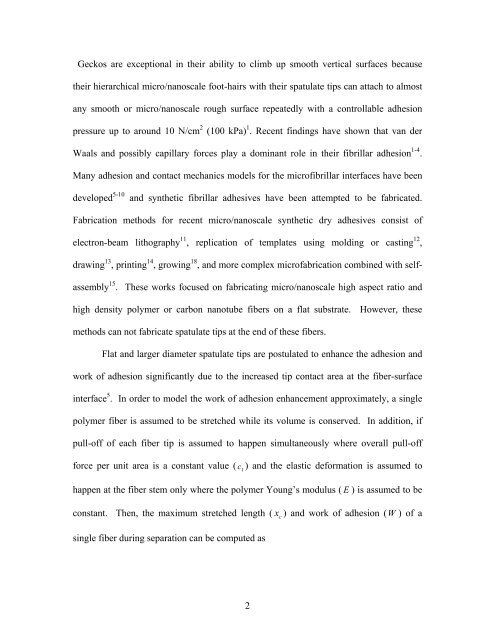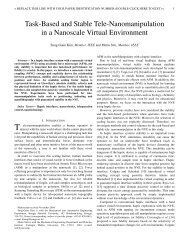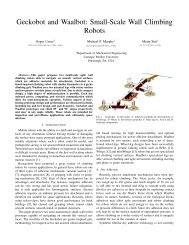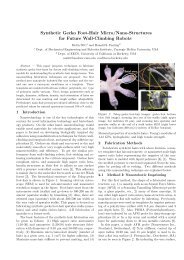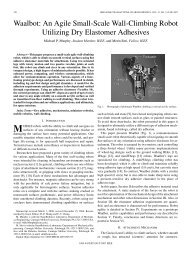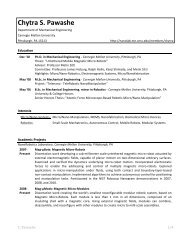View - NanoRobotics Lab - Carnegie Mellon University
View - NanoRobotics Lab - Carnegie Mellon University
View - NanoRobotics Lab - Carnegie Mellon University
You also want an ePaper? Increase the reach of your titles
YUMPU automatically turns print PDFs into web optimized ePapers that Google loves.
Geckos are exceptional in their ability to climb up smooth vertical surfaces because<br />
their hierarchical micro/nanoscale foot-hairs with their spatulate tips can attach to almost<br />
any smooth or micro/nanoscale rough surface repeatedly with a controllable adhesion<br />
pressure up to around 10 N/cm 2 (100 kPa) 1 . Recent findings have shown that van der<br />
Waals and possibly capillary forces play a dominant role in their fibrillar adhesion 1-4 .<br />
Many adhesion and contact mechanics models for the microfibrillar interfaces have been<br />
developed 5-10<br />
and synthetic fibrillar adhesives have been attempted to be fabricated.<br />
Fabrication methods for recent micro/nanoscale synthetic dry adhesives consist of<br />
electron-beam lithography 11 , replication of templates using molding or casting 12 ,<br />
drawing 13 , printing 14 , growing 18 , and more complex microfabrication combined with selfassembly<br />
15 . These works focused on fabricating micro/nanoscale high aspect ratio and<br />
high density polymer or carbon nanotube fibers on a flat substrate. However, these<br />
methods can not fabricate spatulate tips at the end of these fibers.<br />
Flat and larger diameter spatulate tips are postulated to enhance the adhesion and<br />
work of adhesion significantly due to the increased tip contact area at the fiber-surface<br />
interface 5 . In order to model the work of adhesion enhancement approximately, a single<br />
polymer fiber is assumed to be stretched while its volume is conserved. In addition, if<br />
pull-off of each fiber tip is assumed to happen simultaneously where overall pull-off<br />
force per unit area is a constant value (<br />
c 1<br />
) and the elastic deformation is assumed to<br />
happen at the fiber stem only where the polymer Young’s modulus ( E ) is assumed to be<br />
constant. Then, the maximum stretched length (<br />
single fiber during separation can be computed as<br />
x c<br />
) and work of adhesion (W ) of a<br />
2


